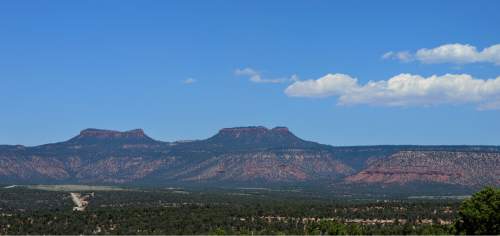This is an archived article that was published on sltrib.com in 2016, and information in the article may be outdated. It is provided only for personal research purposes and may not be reprinted.
Casting wildlands as the backbone of Utah's economic future, outdoor industry leaders Thursday joined a chorus of groups calling on President Barack Obama to designate Bears Ears National Monument. The move is required to protect tens of thousands of archaeological sites hidden in a 1.9 million-acre network of canyons and mesas in southeast Utah, according to Peter Metcalf, founder of Salt Lake City-based Black Diamond Equipment.
"Companies like ours depend on wild, scenic and untrammeled landscapes where our customers can escape to find rejuvenation, discovery and inspiration while doing what they love to do," he told a packed conference room at the Outdoor Retailer summer convention. "Protecting the Bears Ears as a national monument is not only the right action to support American Indian tribes in preserving ancestral lands, but helps to ensure the infrastructure for activities our customers love and use our products for."
Many local residents deeply oppose a monument, fearing it would thwart public access to the land and its natural resources. One man claimed the outdoor industry's support is motivated purely by self-interest.
None of the companies at Thursday's presser "gives a rat's ass about what the tribes want or need. It's all about outdoor recreation and the all mighty dollar," wrote San Juan County employee Monte Perkins in an email.
Participating in the call for a monument were Utah-based Petzl America, Probar, Kühl and Skullcandy; Treasure Mountain Inn in Park City; Gregory Mountain Products; Patagonia; and Osprey Packs, headquartered in Cortez, Colo., 45 miles from the proposed monument.
"We are building a new headquarters. We are adding jobs. We are here to stay," said Osprey's Scott Robertson.
Named for a pair of buttes that rise like ears from the north side of Cedar Mesa, Bears Ears has become a battleground in Utah's public lands debates. A coalition of five tribes with cultural and ancestral ties to these lands have petitioned Obama to use his authority under the Antiquities Act to designate a monument before his tenure ends. They say monument status would help stop the looting and vandalism of ancient Anasazi sites and keep extractive industries and motorized use from marring the landscape, while ensuring continued access for traditional tribal activities such as wood and pine nut gathering.
Other tribal, environmental, sportsmen, historic preservation and faith groups have also called on Obama to designate a monument.
Three local Native Americans pushing for a monument — Mark Maryboy, Regina Lopez-Whiteskunk and Willie Grayeyes — attended the industry event and welcomed these businesses' support for their cause, which is opposed by some Utah Navajo.
State leaders have chastised the Obama administration for considering creating a monument over the wishes of San Juan County leaders, who are pursuing a legislative path to protect the region. Gov. Gary Herbert and others have implored Obama, who has already set aside several large monuments in neighboring states, to allow Rep. Rob Bishop's Public Lands Initiative to work through Congress.
Utah Sen. Mike Lee, who fielded testimony from locals opposing the monument last week, quickly voiced displeasure with the outdoor leaders' announcement.
"It is clear that [locals] do not want big business colluding with the federal government to take away their land and threaten their way of life," Lee said. Locals want to preserve this landscape, "but they want to do so in a way that protects and promotes economic opportunity in their county, which is the poorest in the state."
The conservative Utah think tank Sutherland Institute says monument designations hurt local economies and schools by displacing natural-resource-based employment with low-paying, seasonal tourism jobs that can't support families.
But protecting Bears Ears will shore up Utah's quality of life and thriving economy because such landscapes help attract high-paying employers and a talented workforce, industry leaders say.
"The economic facts show conclusively that communities juxtaposed against protected lands are substantially more prosperous than those that are not," Metcalf said.
Petzl's president, Nazz Kurth, sees a monument designation as a legacy that will far outlive the climbing gear and gadgets his company is showcasing at this year's show. The value of protecting Bears Ears may not be immediately apparent, he said, but setting aside places like Yosemite and Yellowstone were prescient moves, universally applauded now.
"Bears Ears is a treasure, and treasures needed to be managed and protected. When I take [colleagues] to raft and climb and camp in the Bears Ears, they are always blown away," Kurth said. "Visitors come to our state not to see drill rigs, but to see the sweeping landscapes, to experience the sandstone and the majesty of the desert and they spend money when they do that. They support local economies and that's something that is truly renewable over and over again."
Brian Maffly covers public lands for The Salt Lake Tribune. Maffly can be reached at bmaffly@sltrib.com or 801-257-8713. Twitter: @brianmaffly



